



Believe it or not, the Congress of Vienna (1814-1815) greatly simplified the political division of Germany. The Holy Roman Empire of 1648 contained 234 territorial units, with 51 Free Cities, and multiple ecclesiastical states, like the great Archbishoprics of Salzburg, Magdeburg, and Trier and the Bishopric of Münster. Nevertheless, the 32 entities that remained after Vienna (with only 4 Free Cities and no ecclesiastical territories) were still a mess. The "German Confederation" established by the Congress (which makes it sound like the successor of Napoleon's "Confederation of the Rhine"), with exactly the same boundaries as the Empire of 1648, had even less power than the state that, according to Voltaire, was neither Holy, nor Roman, nor an Empire. As an institution the Confederation collapsed when Prussia and Austria went to war in 1866. All the pieces, except for Austria itself, Liechtenstein, and Luxembourg, were then scooped up by Prussia into the new German Empire of 1871. The maps here are based on E.J. Passant, A Short History of Germany, 1815-1945 [Cambridge University Press, 1962]. Some errors in Passant are corrected with sources listed at individual listings. At this scale some detail is lost: There is even more fragmenation than what you see here (e.g. Brunswick was in seven pieces, not just five). Note that in each map, territories in yellow are possessions of non-German states.
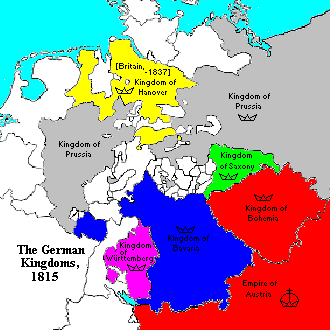
The Austrian Empire was self-proclaimed by the Hapsburgs after Napoleon crowned himself Emperor in 1804. Since Napoleon already was obviously not going to allow the election of another Hapsburg as Holy Roman Emperor, and actually did abolish the Empire in 1806, they were one step ahead of him.
Since the original mediaeval Empire was based on the Kingdom of the East Franks, it never made any sense that there would be other kingdoms inside it. Bohemia was acquired and created a Kingdom by the German Emperors, perhaps with the sense that it was still in some sense external to East Francia; and the Margrave of Brandenburg became the King of Prussia, far outside the Empire. The other Kingdoms were all created either by Napoleon or by the Congress of Vienna after the Holy Roman Empire was abolished. The Kingdom of Saxony suffered the most at the Congress of Vienna, penalized by Prussia for having been an ally of France. Bavaria, although it had been an ally of France also, did rather well at Vienna, retaining the family lands in both the Rhenish and the Upper Palatinate and the extensive lands that had been attached to it by Napoleon. The King of Hanover was also the King of England until 1837, when the Salic Law passed over Queen Victoria. Later this left Hanover, as an ally of Austria, at the mercy of Prussia.
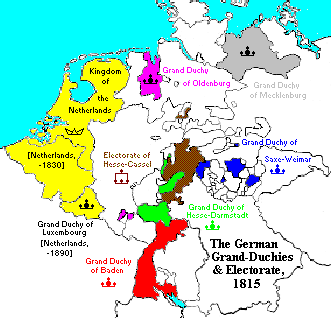
Napoleon made the Landgrave of Hesse-Cassel an Elector of the Holy Roman Empire in 1803. Since this was a much better title than Landgrave, the ruler of Hesse-Cassel got it recognized at the Congress of Vienna. So, until 1866, there was still one Elector of the non-existent Holy Roman Emperor.
Luxembourg lost half its territory when Belgium became independent in 1830. Then in 1890 the Salic Law prevented Queen Wilhelmina from inheriting the Duchy and it became independent. Later, the Salic Law was simply set aside, and two Grand Duchesses have since ruled. The area of Belgium derived from Luxemboug is still called "Luxembourg," which is an interesting situation given, for instance, the objection of Greece to Macedonia calling itself "Macedonia," which the Greeks say implies a claim on Greek Macedonia. So, does Luxembourg claim Belgian Luxembourg, or does Belgium claim all of Luxembourg? I'm confused.
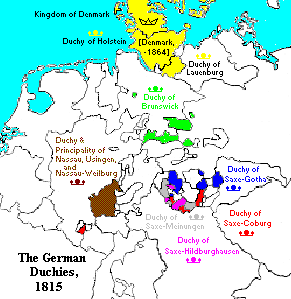
The Duchies of Holstein and Lauenburg were ruled by Denmark, together with the Danish Duchy of Schleswig, which contained both German and Danish speakers. Prussia and Austria occupied the Duchies in 1864, with Austria taking Holstein and Prussia Schleswig. A falling out over this led to the Prussian defeat of Austria in 1866, with Prussia taking all the Duchies. Part of Schleswig was returned to Denmark after World War I, when a plebiscite was mandated by the Treaty of Versailles. A son of the House of Saxe-Coburg-Gotha, Albert, married Queen Victoria of England. Their daughter Victoria married the future Emperor Frederick of Germany. They became the parents of Emperor Wilhelm II.

Liechtenstein discovered, to everyone's surprise, that it was one of the Allies in World War II, because it had never formally ended hostilities, as an ally of Austria, against Prussia in 1866. Passant [A Short History of Germany, 1815-1945] shows some mistakes when it comes to these states. His source, which he says is a map, The German Confederated States [London, 1839], must have contained the errors: (1) What he shows as the "Principalities" of Anhalt had become Duchies in 1806/7; (2) What he shows as the "Principality" of Hesse-Homberg was never a Principality but only a Landgravate; and (3) The Principality of Layen, listed by Passant, is not actually shown on the map. This curiosity is treated under the entry in question. The 1839 map was evidently not quite up to date with some of the small domains.

There had been 51 Free Cities under the Holy Roman Empire. Vienna cut this down to four. Frankfurt held a special status, both as the place of the election of the old Emperors (of their coronation too, after Ferdinand I, and of their portraits, held in the Römer Saal), and as the headquarters of the German Confederation, where a German National Assembly was convened in 1848. The triumph of Prussia ended both Frankfurt's independence and its status. I would like to know why, when West Germany needed a more practical capital than the isolated Berlin, it choose the obscure Bonn rather than Frankfurt, whose historical associations were not only of mediaeval Germany, but of liberal and republican movements in the 19th century. Now, with a reunited Germany, the capital has returned to Berlin, whose associations are entirely of Prussia, Kaiser, and Hitler. See more about Frankfurt under the Rothschild's. Lübeck, Hamburg, and Bremen were the final members of the Hanseatic League, was finally abolished in 1862.


| Counts & Dukes of Berg, Jülich, Mark, & Cleves |
|---|
 But this was disputed by John Sigismund, Elector of Brandenburg, whose mother was John William's sister, and William Wolfgang, Duke of Neuburg, whose mother was another sister. John Sigismund was a Lutheran and William Wolfgang a Calvinist. They pooled their resources, rallied the Protestants (and, well, the French), and managed to expel the Austrians. Their agreement was to share the rule of the Duchies. But they had a falling out. William Wolfgang converted to Catholicism and drew Bavaria and the Catholic League of German princes in on his side. John Sigismund countered by switching to Calvinism, which was more to the liking of Dutch and French Protestants. Despite these maneuvers, the business was settled in 1614 with a provisional partition, Cleves, Mark, and Ravensberg going to Brandenburg, Jülich and Cleves to Neuberg. This was made permanent in 1666. Besides looking something like a preliminary skirmish for the Thirty Years War, this transaction is of interest because it gave Brandenburg, soon to be the Kingdom of Prussia, a foothold on the Rhine. Neuberg was of the House of Wittelsbach, heirs of the Palatinate and Bavaria, all of whose lands would be united in 1777. From the Congress of Vienna, Prussia took away all the lands on both sides of the lower Rhine. One might also note that Anne of Cleves, the 4th wife of King Henry VIII of England, was an aunt of the Duke John William.
But this was disputed by John Sigismund, Elector of Brandenburg, whose mother was John William's sister, and William Wolfgang, Duke of Neuburg, whose mother was another sister. John Sigismund was a Lutheran and William Wolfgang a Calvinist. They pooled their resources, rallied the Protestants (and, well, the French), and managed to expel the Austrians. Their agreement was to share the rule of the Duchies. But they had a falling out. William Wolfgang converted to Catholicism and drew Bavaria and the Catholic League of German princes in on his side. John Sigismund countered by switching to Calvinism, which was more to the liking of Dutch and French Protestants. Despite these maneuvers, the business was settled in 1614 with a provisional partition, Cleves, Mark, and Ravensberg going to Brandenburg, Jülich and Cleves to Neuberg. This was made permanent in 1666. Besides looking something like a preliminary skirmish for the Thirty Years War, this transaction is of interest because it gave Brandenburg, soon to be the Kingdom of Prussia, a foothold on the Rhine. Neuberg was of the House of Wittelsbach, heirs of the Palatinate and Bavaria, all of whose lands would be united in 1777. From the Congress of Vienna, Prussia took away all the lands on both sides of the lower Rhine. One might also note that Anne of Cleves, the 4th wife of King Henry VIII of England, was an aunt of the Duke John William.

The genealogy of Cleves, etc. was complied mainly from the Erzählende genealogische Stammtafeln zur europäischen Geschichte, Volume I, Part 2, Deutsche Kaiser-, Königs-, Herzogs- und Grafenhäuser II [Andreas Thiele, Third Edition, R. G. Fischer Verlag, 1997, pp.599-613], with some details from other volumes. The discussion of the succession dispute draws on The Rise of Brandenburg-Prussia to 1786, by Sidney B. Fay & Klaus Epstein [1937, Holt, Rinehart & Winston, 1964].
| Counts, Dukes & Kings of Württemberg | |
|---|---|
| Louis I | Count, 1137-1181 |
| Emich | 1137-1154 |
| Henry | 1181-1201 |
| Louis II | 1201-1228 |
| Eberhard | 1228-1241 |
| Ulrich I | 1241-1265 |
| Ulrich II | 1265-1279 |
| Eberhard I the Illustrious | 1279-1325 |
| Ulrich III | 1325-1344 |
| Eberhard II the Whiner | 1344-1392 |
| Ulrich IV | 1344-1366 |
| Eberhard III the Mild | 1392-1417 |
| Eberhard IV | 1417-1419 |
| Louis I | Urach, 1419-1441, d.1450 |
| Ulrich V | 1419-1480 |
| Eberhard V, I as Duke | Urach, 1457-1496 |
| Duke, 1495-1496 | |
| Eberhard VI, II as Duke | 1480-1498 |
| Duke, 1496-1498, d.1504 | |
| Ulrich I | 1498-1519, 1534-1550 |
| Austria, 1519-1534 | |
| Christopher | 1550-1568 |
| Louis III the Pious | 1568-1593 |
| Frederick I | 1593-1608 |
| John Frederick | 1608-1628 |
| Eberhard III | 1628-1674 |
| William Louis | 1674-1677 |
| Eberhard IV Louis | 1677-1733 |
| Charles I Alexander | 1733-1737 |
| Charles II Eugene | 1737-1793 |
| Louis Eugene | 1793-1795 |
| Frederick II | 1795-1797 |
| Frederick (III) | Duke, 1797-1806; Elector, 1803-1806 |
| King, 1806-1816 | |
| Ludwig Frederick Alexander | Duke, 1806-1817 |
| William I | 1816-1864 |
| Charles | 1864-1891 |
| German Empire, 1871 | |
| William II | 1891-1918, d.1921 |
| Princes of Liechtenstein | |
|---|---|
| Charles | 1608-1627 |
| Gundakar | 1623-1658 |
| Hartman | 1658-1686 |
| John (Johann/Hans) Adam I | 1699-1712 |
| Joseph Wenzel | 1712-1718, 1748-1772 |
| Anthony Florian | 1718-1721 |
| Joseph John Adam | 1721-1732 |
| John Nepomonk Charles | 1732-1748 |
| Franz Josef I | 1772-1781 |
| Aloysius I | 1781-1805 |
| John I | 1805-1836 |
| Aloysius II | 1836-1858 |
| John II the Good | 1858-1929 |
| Independent, 1866 | |
| Franz | 1929-1938 |
| Franz Josef II | 1938-1989 |
| John III Adam/ Hans Adam II | 1989- |
The Principality is hardly of strategic significance. But when World War I ended, Liechtenstein, to the astonishment of all, came to be counted among the Allies; for its declaration of war against Prussia in 1866 and never formally been ended by any treaty. Strictly speaking, it had been at war with Prussia, grown into Germany, ever since. Meanwhile, its greatest claim to fame seems to have largely come from its postage stamps.
The original flag of Liechtenstein, adopted officially in 1921, is in the bicolor form that is so familiar from German States (and even European states like Poland, Monaco, and San Marino). At the 1936 Olympics, however,  the Liechtensteiners were suprised to discover that their flag was identical to that of Haiti. The crown was therefore added in 1937. The Haitians also modified their flag.
the Liechtensteiners were suprised to discover that their flag was identical to that of Haiti. The crown was therefore added in 1937. The Haitians also modified their flag.
The Heir of Liechtenstein, Aloys (or Alois), has married an heiress, Sophie, of the Wittelsbachs. While the Princes of Liechtenstein are certainly venerable enough, the Wittelsbachs are another matter altogether. But Sophie also happens to be in the line of descent of the British House of Stuart, making her son by Alois, Joseph Wenzel, the Heir of Stuart claims to the British Throne.
 Württemberg, the heart of the old Duchy of Swabia, seems to have avoided most of the spotlight of history. In 1803, Napoleon made it an Electorate of the Holy Roman Empire but then, when he abolished the Empire in 1806, the Duchy was elevated to a Kingdom. Having gone along with the French Empire, Württemberg then went along with the German Empire in 1871, and the Kings survived until all the princely states were abolished in 1918. In modern Germany, the flag of the State of Baden-Württemberg combines the upper black stripe of Württemberg and the lower yellow stripe of Baden.
Württemberg, the heart of the old Duchy of Swabia, seems to have avoided most of the spotlight of history. In 1803, Napoleon made it an Electorate of the Holy Roman Empire but then, when he abolished the Empire in 1806, the Duchy was elevated to a Kingdom. Having gone along with the French Empire, Württemberg then went along with the German Empire in 1871, and the Kings survived until all the princely states were abolished in 1918. In modern Germany, the flag of the State of Baden-Württemberg combines the upper black stripe of Württemberg and the lower yellow stripe of Baden.
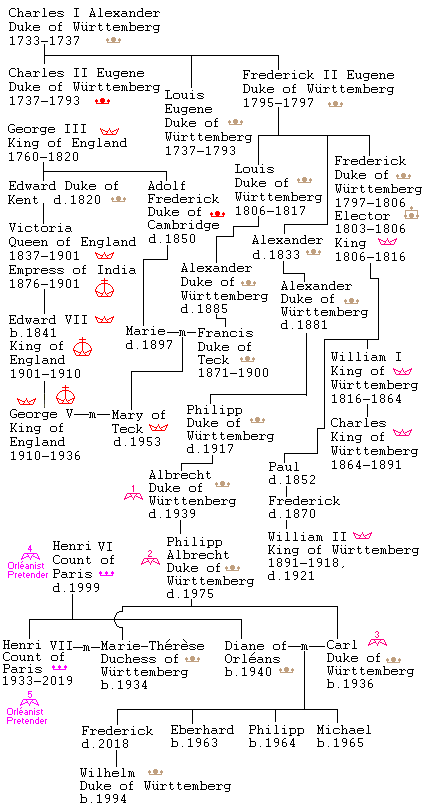
The genealogy for some of the last Dukes and most of the Kings of Württemberg highlights a connection to the British Royal Family. Queen Mary of Teck, of the House of Württemberg, wife of King George V, was also a great-granddaugher of King George III, through her mother. The great Queen Mary oceanliner, now permanently docked in Long Beach, California, is named after Mary of Teck. The story is that the President of the Cunard line told King George V that their new ship would be name after the most illustrious Queen in British history, meaning Elizabeth I. However, King George then thanked him and said that Queen Mary would be flattered. So the Cunard line named the ship after Mary.
The list for Württemberg was taken entirely from Brian Tompsett's Royal and Noble genealogy. The genealogy for Württemberg was from the Erzählende genealogische Stammtafeln zur europäischen Geschichte, Volume I, Part 2, Deutsche Kaiser-, Königs-, Herzogs- und Grafenhäuser II [Andreas Thiele, Third Edition, R. G. Fischer Verlag, 1997, pp.342-346]. The list for Liechtenstein comes from Tompsett and Bruce R. Gordon's Regnal Chronologies. The genealogy has now been updated simply with information from Wikipedia. I had originally missed the descent of King William II. Since William himself had no sons, the Throne of Württemberg would have passed to Albrecht, on a collaterial line. However, by then the Kingdom no longer existed. The reversed crown for "pretenders" simply indicates the descent of the Head of the House of Württemberg. Since we tend to find disposessed royality often still marrying each other, we have the striking case here of the intermarriage of Württemberg with the family of the Orléanist Pretenders to the Thone of France.
| Lords, Counts, & Princes of Lippe | |||
|---|---|---|---|
| Herman of Lippe | d.1096 | ||
| Bernard I | Lord, 1123-1158 | ||
| Herman I | 1124-1160 | ||
| Bernard II | 1160-1224 | ||
| Herman II | 1196-1229 | ||
| Simon | 1229-1277 | ||
| Bernard III | 1229-1265 | ||
| Herman III | 1265-1274 | ||
| Bernard IV | 1265-1275 | ||
| Simon I | 1275-1344 | ||
| Simon II | d.1334 | ||
| Otto | 1344-1360 | ||
| Bernard V | 1344-1365 | ||
| Simon III | 1360-1410 | ||
| Bernard VI | 1410-1415 | ||
| Simon IV | 1415-1429/30 | ||
| Bernard VII the Warlike | 1430-1511 | ||
| Simon V | 1511-1528 | ||
| Count, 1528-1536 | |||
| Bernard VIII | 1536-1563 | ||
| Simon VI | 1563-1613 | ||
| Simon VII | Detmold, 1613-1627 | Philip I | Schaumburg, 1647-1681 |
| Simon Louis | 1627-1636 | ||
| Simon Philip | 1636-1650 | ||
| John Bernard | 1650-1652 | ||
| Herman Adolph | 1652-1666 | ||
| Simon Henry | 1666-1697 | Frederick Christian | 1681-1728 |
| Frederick Adolph | 1697-1718 | ||
| Simon Henry Adolph | 1718-1720 | ||
| Prince, 1720-1734 | Albert Wolfgang | 1728-1748 | |
| Simon Augustus | 1734-1782 | William Frederick, Don Quixote | 1748-1777 |
| Leopold I | 1782-1802 | Philip II | 1777-1787 |
| George I | 1787-1807 | ||
| Leopold II | 1802-1851 | Prince, 1807-1860 | |
| Leopold III | 1851-1875 | Adolph I | 1860-1893 |
| Woldemar | 1875-1895 | ||
| Alexander | 1895-1905 | George II | 1893-1911 |
| Leopold IV of Lippe-Biesterfeld | 1905-1918, d.1949 | Adolph II | 1911-1918, d.1936 |
This list is taken entirely out of the Erzählende genealogische Stammtafeln zur europäischen Geschichte, Volume I, Part 2, Deutsche Kaiser-, Königs-, Herzogs- und Grafenhäuser II [Andreas Thiele, Third Edition, R. G. Fischer Verlag, 1997].
| The Descent of the Hohenzollern |
 Other another continued in small Counties, later Principalities, in southern Germany, to be reunited in the service, at least, of the Northern family, and to contribute Royalty to Romania.
Other another continued in small Counties, later Principalities, in southern Germany, to be reunited in the service, at least, of the Northern family, and to contribute Royalty to Romania.
With, probably, little enough to do in their small Counties, many of the Counts occupied themselves in military service to the Emperors; and in one generation, no less than three brothers were killed in the struggle that the Emperor Maximilian waged against France to secure the Burgundian Succession.
After Count Charles I's death in 1576, the Southern succession simplified to two lines, as given below.
This genealogy is taken entirely out of the Erzählende genealogische Stammtafeln zur europäischen Geschichte, Volume I, Part 1, Deutsche Kaiser-, Königs-, Herzogs- und Grafenhäuser I [Andreas Thiele, Third Edition, R. G. Fischer Verlag, 1997].
Counts & Princes of Hohenzollern Henchingen-Sigmaringen
Hohenzollern Margraves & Electors of Brandenburg
Hohenzollern Emperors of German "Second Reich"
| Counts & Princes of Hohenzollern |
 north of Lake Constance. Hechingen and Sigmaringen separated in 1575. The division between this line of southern Princes and the northern Hohenzollerns of Brandenburg was with two sons of Frederick I, Burggraf of Nuremberg, who died around 1200. One son, Conrad I (d.1260/61), led to the northern Hohenzollerns, the other, Frederick II (d.1251/55), led to the southern Hohenzollerns. The ten generations that separate Frederick II from Charles I in the genealogy at left are given in the table at The Descent of the Hohenzollern above.
north of Lake Constance. Hechingen and Sigmaringen separated in 1575. The division between this line of southern Princes and the northern Hohenzollerns of Brandenburg was with two sons of Frederick I, Burggraf of Nuremberg, who died around 1200. One son, Conrad I (d.1260/61), led to the northern Hohenzollerns, the other, Frederick II (d.1251/55), led to the southern Hohenzollerns. The ten generations that separate Frederick II from Charles I in the genealogy at left are given in the table at The Descent of the Hohenzollern above.
In 1849 both Princes abdicated and ceded the whole Principality to their distance cousin, the King of Prussia. They were rewarded in 1850 with royal status and important commissions under the Kingdom. Charles Anthony, the last sovereign prince of Sigmaringen, was even the Prime Minister of Prussia from 1858 to 1862, not long (6 months) before Otto von Bismarck. The heirs of Sigmaringen, however, found sovereinty elsewhere, as Kings of Romania. All the Kings of Romania and the surviving heirs are Hohenzollerns.
This genealogy is taken out of the Erzählende genealogische Stammtafeln zur europäischen Geschichte, Volume I, Part 1, Deutsche Kaiser-, Königs-, Herzogs- und Grafenhäuser I [Andreas Thiele, Third Edition, R. G. Fischer Verlag, 1997], with the Romanian information from Erzählende genealogische Stammtafeln zur europäischen Geschichte, Volume II, Part 2, Europäische Kaiser-, Königs-, und Fürstenhäuser II [Andreas Thiele, Second Edition, R. G. Fischer Verlag, 1997], with updates from Wikipedia.
The Descent of the Hohenzollern
Hohenzollern Margraves & Electors of Brandenburg
Hohenzollern Emperors of German "Second Reich"
| Landgraves of Hesse-Homburg | |
|---|---|
| Frederick I | Landgrave, 1622-1638 |
| William Christopher | 1650-1669 |
| George Christian | 1669-1677 |
| Frederick II | 1680-1708 |
| Frederick III | 1708-1746 |
| Frederick IV | 1746-1751 |
| Frederick V | 1751-1806, 1815-1820 |
| Frederick VI | 1820-1829 |
| Louis | 1829-1839 |
| Philip | 1839-1846 |
| Gustav | 1846-1848 |
| Ferdinand | 1848-1866 |
| passses to Hesse-Darmstadt, then Prussia, 1866 | |
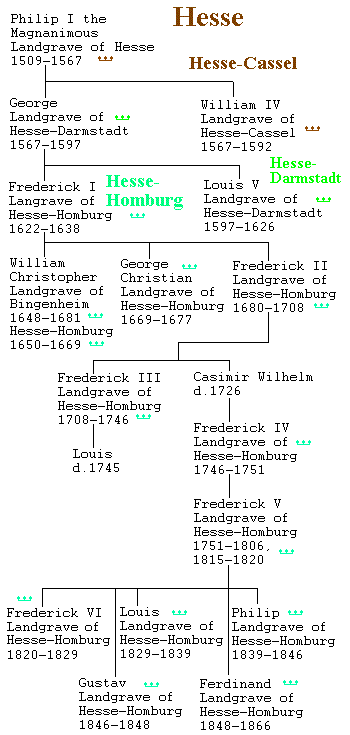
Hesse-Homburg was a very tiny fragment of Hesse, consisting of little more than the city of Homburg and its environs, just north of Frankfurt-am-Main. Taken by Napoleon for the Confederation of the Rhine, it was restored by the Congress of Vienna. After all five sons of Frederick V served as Landgrave and died without male heir, title reverted in 1866 to what had become the Grand Duchy of Hesse-Darmstadt. However, Prussia annexed Hesse-Cassel in 1866, and for some reason Homburg ended up in the catch.
This list and genealogy is taken entirely out of the Erzählende genealogische Stammtafeln zur europäischen Geschichte, Volume I, Part 2, Deutsche Kaiser-, Königs-, Herzogs- und Grafenhäuser II [Andreas Thiele, Third Edition, R. G. Fischer Verlag, 1997].
| The Zähringens & Baden |
With the decline of German Imperial power, the Zähringen family appeared to be poised as the local successors to power in the Southwest of Germany and in the Northwest of the old Kingdom of Burgundy. By founding the city of Bern in 1191, Duke Berthold V of Zähringen indicates to us one of the centers of Zähringen power. Burgundy east of the Jura and west of the Reuss River was known as the "Lesser Duchy" of Burgundy (Burgundia Minor, klein Burgund), while around Bern itself was the Landgravate (Landgrafschaft) of Burgundy. However, Berthold died without heirs. Bern itself was made a Imperial City by the Emperor Frederick II in 1218. Andreas Thiele says of Berthold, "sein erbenloser Tod bedeutet den völligen Zerfall des deutschen Sudwestens(!)"
 [Erzählende genealogische Stammtafeln zur europäischen Geschichte, Volume I, Part 2, Deutsche Kaiser-, Königs-, Herzogs- und Grafenhäuser II, Third Edition, R. G. Fischer Verlag, 1997, p.352], "his death without heirs meant the complete disintegration of the German Southwest." This disintegration allowed for the development of Switzerland, in whose shadow Burgundy is forgotten. Bern joined the Swiss Confederation in 1353.
[Erzählende genealogische Stammtafeln zur europäischen Geschichte, Volume I, Part 2, Deutsche Kaiser-, Königs-, Herzogs- und Grafenhäuser II, Third Edition, R. G. Fischer Verlag, 1997, p.352], "his death without heirs meant the complete disintegration of the German Southwest." This disintegration allowed for the development of Switzerland, in whose shadow Burgundy is forgotten. Bern joined the Swiss Confederation in 1353.
Meanwhile, however, a collateral line of the family had become the Margraves of Baden. They continued there until the 20th century.
| Margraves & Grand Dukes of Baden; Zähringens | |
|---|---|
| Herman I | 1064-1073, d. 1074 |
| Herman II | 1073-1130 |
| Margrave of Baden, 1112 | |
| Herman III | 1130-1160 |
| Herman IV | 1160-1190 |
| Herman V | 1190-1243 |
| Herman VI | 1243-1250 |
| Frederick I | 1250-1268 |
| Rudolf I | 1243-1288 |
| Rudolf II | 1288-1295 |
| Hesso | 1288-1297 |
| Rudolf Hesso | 1297-1335 |
| Rudolf III | 1288-1332 |
| Herman VII | 1288-1291 |
| Frederick II | 1291-1333 |
| Herman VIII | 1333-1353 |
| Rudolf IV | 1291-1348 |
| Rudolf V | 1348-1361 |
| Frederick III | 1348-1353 |
| Rudolf VI | 1353-1372 |
| Rudolf VII | 1372-1391 |
| Bernard I | 1372-1431 |
| James I | 1431-1453 |
| George | 1453-1454, d. 1484 |
| Bernard II | 1453-1458 |
| Charles I | 1453-1475 |
| Christopher I | 1475-1515, d.1527 |
| Philip I | 1515-1533 |
| Ernest | 1515-1552, d.1553 |
| Baden-Durlach, 1535 | |
| Bernard IV | 1552-1553 |
| Charles II | 1552-1577 |
| Ernest Frederick | 1577-1590 |
| James III | 1577-1590 |
| Ernest James | 1590-1591 |
| George Frederick | 1577-1622, d.1638 |
| Frederick V | 1622-1659 |
| Frederick VI | 1659-1677 |
| Frederick VII | 1677-1709 |
| Charles III William | 1709-1738 |
| founds Karlsruhe | |
| Karl Friedrich | 1738-1811 |
| inherits Baden-Baden, 1771 | |
| Elector, 1803; Grand Duke, 1806 | |
| Karl | 1811-1819 |
| Ludwig I | 1818-1830 |
| Leopold | 1830-1852 |
| Ludwig II | 1852-1856, d.1858 |
| Friedrich I | 1856-1907 |
| German Empire, 1871 | |
| Friedrich II | 1907-1918, d.1928 |
Baden was a relatively large state along the east bank of the Rhine, running north deep into Germany, and in the south along the Swiss border all the way to Lake Constance. Two branches of the Margravate divided in 1535, but the Baden-Baden line ended in 1771.
| Bernard III | 1515-1536 |
| Baden-Baden, 1535 | |
| Christopher II | 1536-1556, d.1575 |
| Edward Fortunatus | 1588-1594, d.1600 |
| Philibert | 1536-1569 |
| Philip II | 1569-1588 |
| William | 1622-1677 |
| Hermann (d.1691), son of William, commanded 2nd Imperial & Saxon infantry, Center of Christian Relief Army at Siege of Vienna, 1683 | |
|---|---|
| Louis William | 1677-1707 |
| Defeats Turks with Imperial Army in Hungary, 1686; Blenheim campaign with Eugene of Savoy & Duke of Marlborough, 1704; dies of wound | |
| Louis George | 1707-1761 |
| Augustus George | 1761-1771 |
The most outstanding figure of either line may have been Louis William of Baden-Baden, who as an Imperial General defeated the Turks in 1686 and then campaigned in the War of the Spanish Succession with Eugène of Savoy (whose aunt Louise was his mother) and John Churchill, the Duke of Marlborough, who had marched into Bavaria from Flanders.
Unfortunately, Louis William was of the old school of commanders who liked sieges and disliked pitched battles. Since both Marlborough and Eugène intended to fight battles, this was not a good match; yet the Margrave, who was also pretty self-important, was the one nominallly in command.
Having sent Eugène off, the Duke persuaded Louis William that they needed to take the crossing of the Danube at Donauworth, which was defended by the fortress of Schellenberg, which had only ever fallen to one enemy, Gustavus Adolphus of Sweden. With great personal bravery the Margrave may have actually carried the day and won the battle, but he was wounded in the process. His horse fell on him and crushed his foot. This wound was to cost him his life, but at first its severity was not apparent.
This action was preliminary to the Battle of Blenheim. Marlborough and Eugène knew that a battle against what were actually superior French forces would not be agreeable to the Margrave. 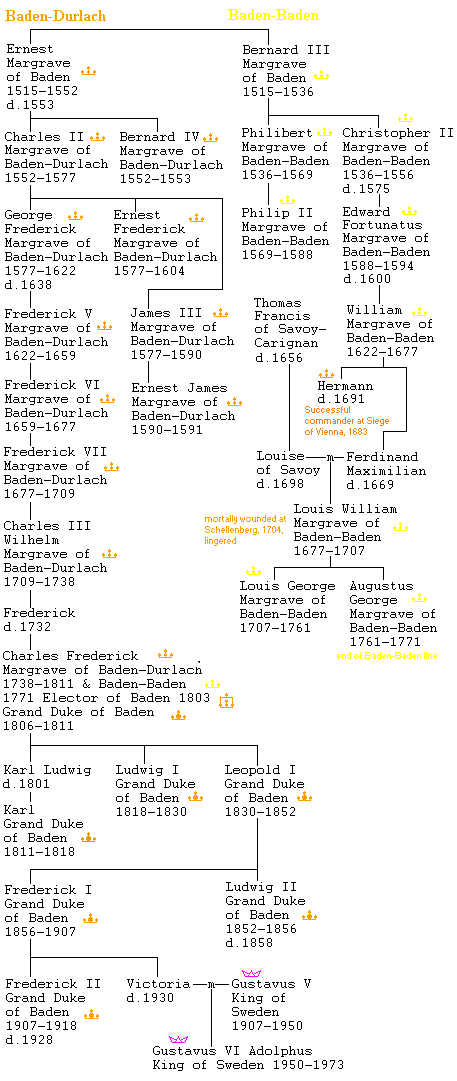 Since they knew he liked sieges, they urged him to attack the city of Ingolstadt; and he took the bait. When Marlborough and Eugène then combined to defeat the French, Louis William perceived their trick, was furious, and never forgave them -- despite the certainty that he would not have agreed to their action in the first place -- as he in fact obstructed their efforts to follow up on the victory. Indeed, he went on to besiege Landau, which ate up the rest of the compaigning season, rather proving the point for Marlborough and Eugène.
Since they knew he liked sieges, they urged him to attack the city of Ingolstadt; and he took the bait. When Marlborough and Eugène then combined to defeat the French, Louis William perceived their trick, was furious, and never forgave them -- despite the certainty that he would not have agreed to their action in the first place -- as he in fact obstructed their efforts to follow up on the victory. Indeed, he went on to besiege Landau, which ate up the rest of the compaigning season, rather proving the point for Marlborough and Eugène.
In subsequent operations, as Louis William seemed to hesitate and prevaricate, Eugene and Churchill began to suspect him of disaffection or even dealing with the French. This was probably a combination of his continuing resentment and trouble from his unhealed foot. Only his death revealed the sad truth, that he had been laboring with a mortal wound.
Louis William's uncle, Hermann, had distinguished himself before Vienna in 1683. Commanding troups intended as a reserve, Hermann nevertheless attacked the Turks, with great success.
Napoleon bestowed the office of Elector of the Holy Roman Empire on Baden in 1803; but this didn't last long, since Napoleon then abolished the Empire in 1806. In compensation, Karl Friedrich was made a Grand Duke. Subsequent Dukes were wise enough not to oppose Prussia; Baden joined the German Empire in 1871; and Zähringen rule lasted until the German princely states were all abolished in 1918.
This list and genealogy was originally taken entirely from Brian Tompsett's Royal and Noble genealogy. Now additions and corrections are from the Erzählende genealogische Stammtafeln zur europäischen Geschichte, Volume I, Part 2, Deutsche Kaiser-, Königs-, Herzogs- und Grafenhäuser II [Andreas Thiele, Third Edition, R. G. Fischer Verlag, 1997, "Zähringen," pp.351-352, & "Baden," pp.357-375].
| Counts & Princes of Schwarzburg |
 The first Count of Schwarzburg, in the midst of the Saxon Duchies, was Sizzo III, who died in 1160. Twelve generations elapse from Sizzo to Henry XXXI, as shown at left.
The first Count of Schwarzburg, in the midst of the Saxon Duchies, was Sizzo III, who died in 1160. Twelve generations elapse from Sizzo to Henry XXXI, as shown at left.
Various branch lines, Leutenberg, Käfernburg, Wachsenburg, and Blankenburg, had reduced to two by 1815, Sonderhausen and Rudolstadt, both of which derived from Günther XL of Blankenburg. At left only the direct line of Blankerburg is shown. Below, the full lines of Sonderhausen and Rudolstadt are given.
Conveniently, the Rival Emperor, Günther of Schwarzburg, is in the Blankenburg line, the brother of Henry X. He was killed in battle against the Emperor Charles IV.
This genealogy is taken entirely out of the Erzählende genealogische Stammtafeln zur europäischen Geschichte, Volume I, Part 2, Deutsche Kaiser-, Königs-, Herzogs- und Grafenhäuser II [Andreas Thiele, Third Edition, R. G. Fischer Verlag, 1997].
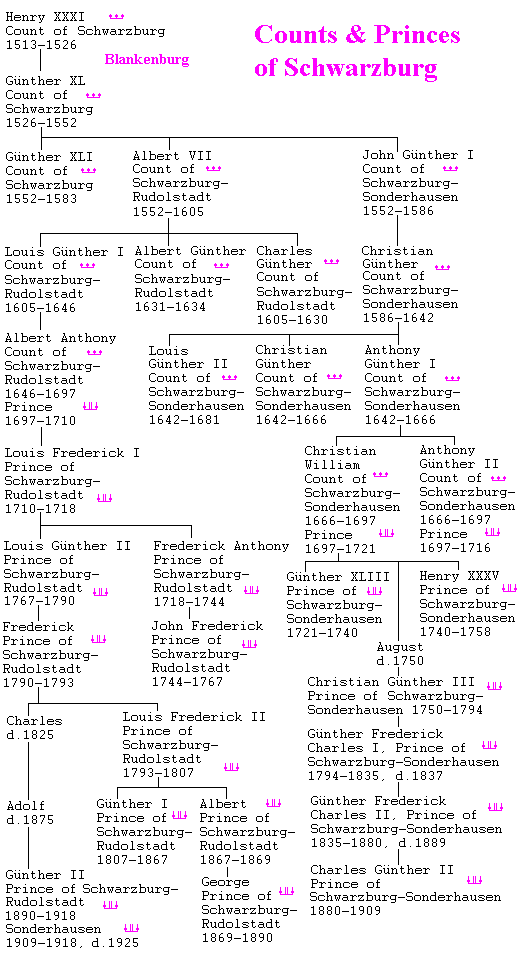
Both Sonderhausen and Rudolstadt lines became Principalities in 1697.
The last Sonderhausen Prince died in 1909 and the whole of Schwarzburg was reunified, but this was just in time for the princely states to end in 1918.
| Princes & Dukes of Anhalt |
 He himself then has no less than five sons among whom the Principality becomes fragmented all over again. The first Prince of Anhalt was Henry I in 1212. From Henry to Joachim Ernest was nine generations.
He himself then has no less than five sons among whom the Principality becomes fragmented all over again. The first Prince of Anhalt was Henry I in 1212. From Henry to Joachim Ernest was nine generations.
Far and away the most noteworthy connection of the House of Anhalt is the marriage of Sophia Augusta, daughter of Christian Augustus of Anhalt- Zerbst, to the Russian Tsar Peter III (d.1762). Sophia Augusta quickly becomes the Sovereign in her own right, as the Empress Catharine II the Great of Russia. The subsequent Romanov family is all descended from her.
In 1806 and 1807 Napoleon made the three remaining Princes of Anhalt into Dukes. The male line of Anhalt-Köthen then died out in 1847, and the line of Anhalt-Bernburg in 1863. Anhalt-Dessau thus gathers in all of Anhalt, though of course the Duke then joined the German Empire in 1871, and all power was lost in 1918.
This genealogy is taken entirely out of the Erzählende genealogische Stammtafeln zur europäischen Geschichte, Volume I, Part 2, Deutsche Kaiser-, Königs-, Herzogs- und Grafenhäuser II [Andreas Thiele, Third Edition, R. G. Fischer Verlag, 1997].
| Counts & Princes of Waldeck | |
|---|---|
| Adolf I of Schwalenberg | Count, 1228-1270 |
| Adolf II | 1270-1302 |
| Otto I | 1276-1305 |
| Henry IV | 1305-1348 |
| Otto II | 1344-1369 |
| Henry VI | 1369-1397 |
| Henry VII | 1397-1442 |
| Wolrad I | 1442-1475 |
| Philip I | 1475 |
| Philip II | 1475-1524 |
| Philip III | 1524-1539 |
| Wolrad II | 1539-1578 |
| Josiah | 1578-1588 |
| Wolrad IV | 1588-1640 |
| Christian | 1588-1637 |
| Philip VII | 1637-1645 |
| Christian Louis | 1645-1706 |
| George Friedrich (d.1690), son of Wolrad IV, commanded Center of Christian Relief Army at Siege of Vienna, 1683 | |
| Anthony Ulrich | 1706-1712, Prince, 1712-1728 |
| Christian Philip | 1728 |
| Charles | 1728-1763 |
| Frederick I | 1763-1812 |
| George I | 1812-1813 |
| George II | 1813-1845 |
| George Victor | 1845-1893 |
| Frederick II | 1893-1918, d.1946 |
This list is taken entirely out of the Erzählende genealogische Stammtafeln zur europäischen Geschichte, Volume I, Part 2, Deutsche Kaiser-, Königs-, Herzogs- und Grafenhäuser II [Andreas Thiele, Third Edition, R. G. Fischer Verlag, 1997].
| Lords of Gondorf & Adendorf, Lords, Counts, & Prince of Leyen |
 E.J. Passant's A Short History of Germany, 1815-1945 [Cambridge University Press, 1962] lists a "Principality of Layen" as one of the members of the German Confederation in 1815. However, Layen is not then shown on the attendant map. His source, which he says is a map, The German Confederated States [London, 1839], must have contained this anomaly. A correspondent then called to my attention the entry for "Leyen" in Bruce R. Gordon's Regnal Chronologies. Gordon explained that Leyen was a Principality by dispensation of Napoleon from 1806 to 1814. If Leyen is then Passant's "Layen," in 1815 it had already been annexed to Baden. Gordon says that Leyen was "a small territory in the Rhineland, between Speyer and Worms" and that it was ruled by the "Lords of Adendorf" who "became Barons of the Empire in 1653, and Counts of the Empire
in 1711."
E.J. Passant's A Short History of Germany, 1815-1945 [Cambridge University Press, 1962] lists a "Principality of Layen" as one of the members of the German Confederation in 1815. However, Layen is not then shown on the attendant map. His source, which he says is a map, The German Confederated States [London, 1839], must have contained this anomaly. A correspondent then called to my attention the entry for "Leyen" in Bruce R. Gordon's Regnal Chronologies. Gordon explained that Leyen was a Principality by dispensation of Napoleon from 1806 to 1814. If Leyen is then Passant's "Layen," in 1815 it had already been annexed to Baden. Gordon says that Leyen was "a small territory in the Rhineland, between Speyer and Worms" and that it was ruled by the "Lords of Adendorf" who "became Barons of the Empire in 1653, and Counts of the Empire
in 1711."
| Lords, Counts, & Prince of Layen/Leyen | |
|---|---|
| Hugo Ernest | 1653-1665 |
| Charles Caspar | 1665-1711 |
| Count, 1711-1739 | |
| Frederick Ferdinand Francis Anthony | 1739-1760 |
| Francis Charles | 1760-1775 |
| Philip Francis | 1775-1814 |
| Prince of Leyen, 1806-1814, d.1829 | |
| to Baden, 1814 | |
I then was able to find Leyen in the Erzählende genealogische Stammtafeln zur europäischen Geschichte, Volume III, Ergänzungsband [Andreas Thiele, Second Edition, R. G. Fischer Verlag, 2001, p.68]. Thiele lists Hugo Ernest, whom he says became a Reichs-Freiherr of Leyen in 1663, which must be Gordon's "Baron of the Empire" (though off by ten years), but then has him dying in 1665, not Gordon's 1670. Unfortunately, Thiele does not list the descendants of Hugo Ernest, but he does say that they became Counts in 1711 (agreeing with Gordon) and Princes in 1806. We do get mention of a subsequent Count, Francis Charles, who is cited, as "Karl," as the husband of Maria Anna Helene of Dalberg (d.1804, p.10). It is certainly Francis Charles since he is listed as a Count of Leyen who died in 1775. There is another connecton between Leyen and Dahlberg, since earlier a niece of Hugo Ernest, Anna Catharine, married Philip Francis Eberhard, Treasurer of Worms and great-grandfather of Maria Anna Helene. Also Hugo Ernest was a brother of Karl Kaspar, Archbishop Elector of Trier (not the Charles Caspar who succeeds Hugo Ernest).
Further information has now come from a correspondent in the Netherlands, who has provided the entire genealogy of Gondorf-Adendorf-Leyen from Detlev Schwennicke's Europäische Stammtafeln, Standesherrliche Häuser I, Neue Folge, Volume IV (Verlag J.A. Stargardt, Marburg, 1981, tables 39-42). I have reproduced this above at right, beginning with Werner. The ancestor of the line is said to have been Engelbertus of Guntreve (Gondorf), who was living around 1158-1160. Schwenniche also has Hugo Ernest dying in 1665, but then has him becoming the Reichs-Freiherr in 1653, not 1663 like Thiele.